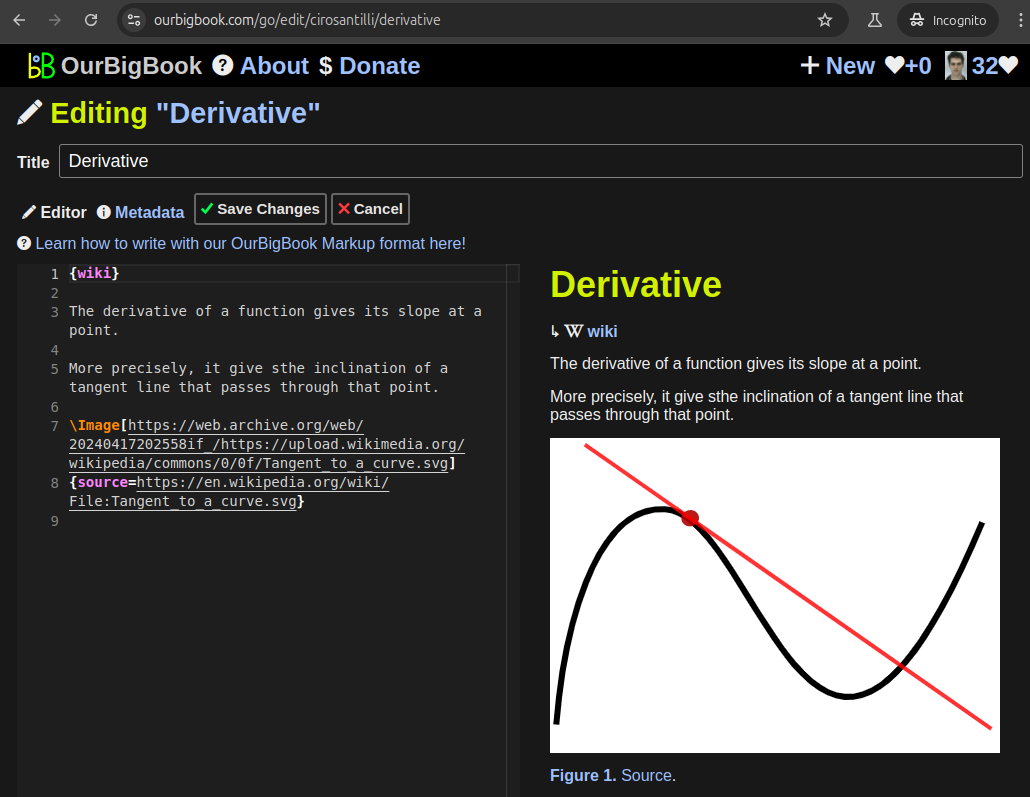Aratu Week 2024 Talk by Ciro Santilli: My Best Random Projects Publish from local markup files by  Ciro Santilli 37 Created 2024-09-04 Updated 2025-07-16
Ciro Santilli 37 Created 2024-09-04 Updated 2025-07-16
- cirosantilli.com (static)
- ourbigbook.com/cirosantilli (dynamic)
Visual Studio Code extension installation
. Visual Studio Code extension tree navigation
. Aratu Week 2024 Talk by Ciro Santilli: My Best Random Projects Web editor with side by side preview by  Ciro Santilli 37 Created 2024-09-04 Updated 2025-07-16
Ciro Santilli 37 Created 2024-09-04 Updated 2025-07-16
Web editor
. You can also edit articles on the Web editor without installing anything locally. Aratu Week 2024 Talk by Ciro Santilli: My Best Random Projects An anonymous donor gave me 1000 Monero (~126,000 USD) to work on this on March 2024 by  Ciro Santilli 37 Created 2024-09-04 Updated 2025-07-16
Ciro Santilli 37 Created 2024-09-04 Updated 2025-07-16
Aratu Week 2024 Talk by Ciro Santilli: My Best Random Projects Topics: the best version of an article by other users by  Ciro Santilli 37 Created 2024-09-04 Updated 2025-07-16
Ciro Santilli 37 Created 2024-09-04 Updated 2025-07-16
Aratu Week 2024 Talk by Ciro Santilli: My Best Random Projects My obsession: find every image before ordinals by  Ciro Santilli 37 Created 2024-09-04 Updated 2025-07-16
Ciro Santilli 37 Created 2024-09-04 Updated 2025-07-16
Aratu Week 2024 Talk by Ciro Santilli: My Best Random Projects Ordinal ruleset inscription (2022): the end of the line by  Ciro Santilli 37 Created 2024-09-04 Updated 2025-07-16
Ciro Santilli 37 Created 2024-09-04 Updated 2025-07-16
Aratu Week 2024 Talk by Ciro Santilli: My Best Random Projects Political memes? by  Ciro Santilli 37 Created 2024-09-04 Updated 2025-07-16
Ciro Santilli 37 Created 2024-09-04 Updated 2025-07-16
Aratu Week 2024 Talk by Ciro Santilli: My Best Random Projects Nuclear weapon designs? by  Ciro Santilli 37 Created 2024-09-04 Updated 2025-07-16
Ciro Santilli 37 Created 2024-09-04 Updated 2025-07-16
Aratu Week 2024 Talk by Ciro Santilli: My Best Random Projects Pedobear memes? by  Ciro Santilli 37 Created 2024-09-04 Updated 2025-07-16
Ciro Santilli 37 Created 2024-09-04 Updated 2025-07-16
Aratu Week 2024 Talk by Ciro Santilli: My Best Random Projects The hard: finding new IP ranges! by  Ciro Santilli 37 Created 2024-09-04 Updated 2025-07-16
Ciro Santilli 37 Created 2024-09-04 Updated 2025-07-16
Aratu Week 2024 Talk by Ciro Santilli: My Best Random Projects The easy: IP range searches by  Ciro Santilli 37 Created 2024-09-04 Updated 2025-07-16
Ciro Santilli 37 Created 2024-09-04 Updated 2025-07-16
Aratu Week 2024 Talk by Ciro Santilli: My Best Random Projects Starting point: 2022 Reuters article by  Ciro Santilli 37 Created 2024-09-04 Updated 2025-07-16
Ciro Santilli 37 Created 2024-09-04 Updated 2025-07-16
Aratu Week 2024 Talk by Ciro Santilli: My Best Random Projects Prelude: initial reports without specific websites by  Ciro Santilli 37 Created 2024-09-04 Updated 2025-07-16
Ciro Santilli 37 Created 2024-09-04 Updated 2025-07-16
Aratu Week 2024 Talk by Ciro Santilli: My Best Random Projects Trended on Hacker News, that's how I met Boiatech people who called me for this talk by  Ciro Santilli 37 Created 2024-09-04 Updated 2025-07-16
Ciro Santilli 37 Created 2024-09-04 Updated 2025-07-16
Aratu Week 2024 Talk by Ciro Santilli: My Best Random Projects Coolest findings: examples of USA spying on its "allies" by  Ciro Santilli 37 Created 2024-09-04 Updated 2025-07-16
Ciro Santilli 37 Created 2024-09-04 Updated 2025-07-16
Adam Curtis has some good documentaries about this, e.g. Section "Can't get you out of my head by Adam Curtis (2021)"
Docs: quartz.jzhao.xyz/
Sponsored by Obsidian itself!
Written in TypeScript!
Markdown support!
Everything is forcibly is scoped to files quartz.jzhao.xyz/features/wikilinks:
[[Path to file#anchor|Anchor]]Global table of contents based of in-disk file structure: quartz.jzhao.xyz/features/explorer with customizable sorting/filtering.
Unlisted articles are being shown, click here to show only listed articles.










